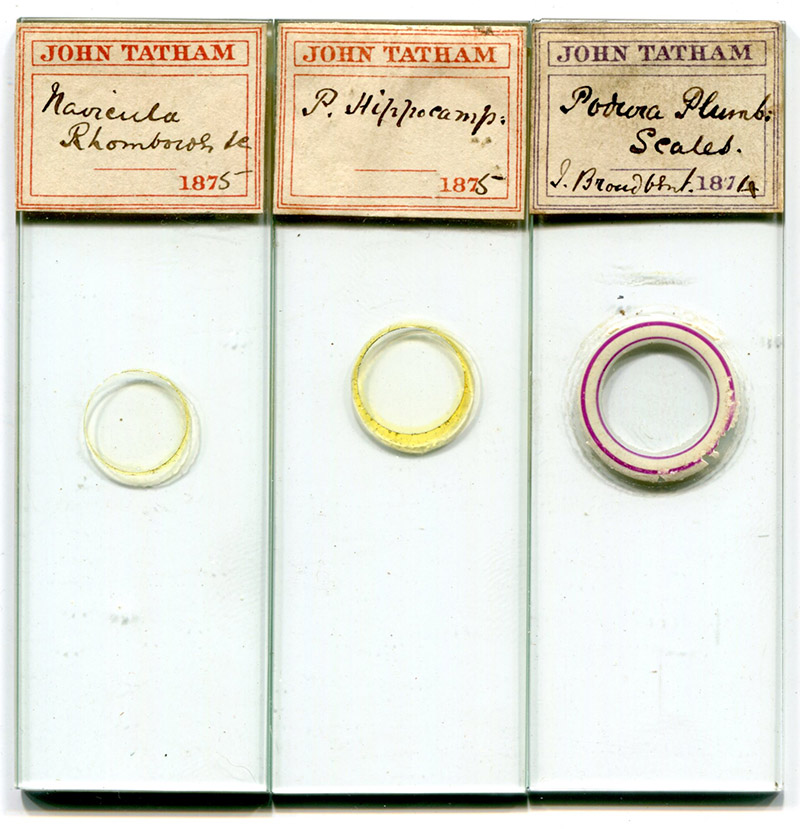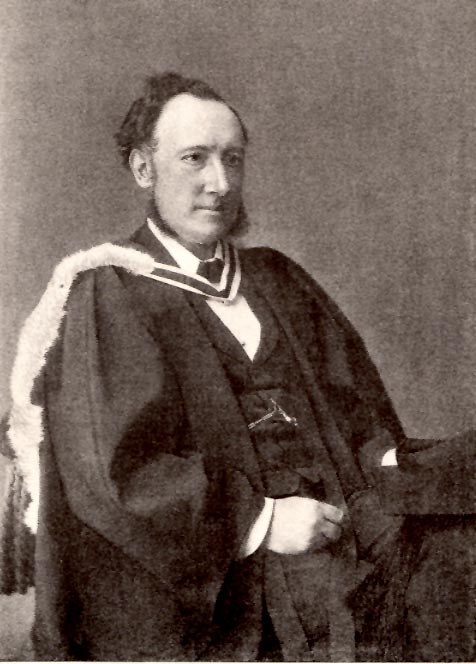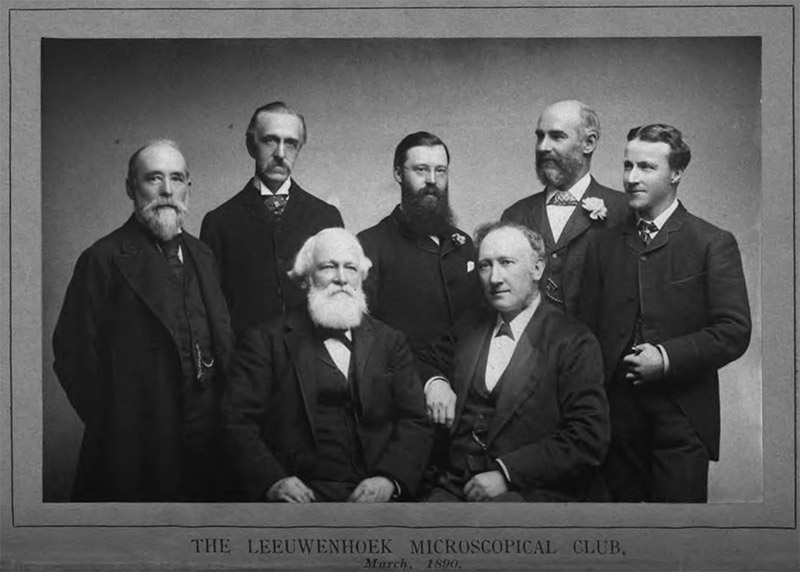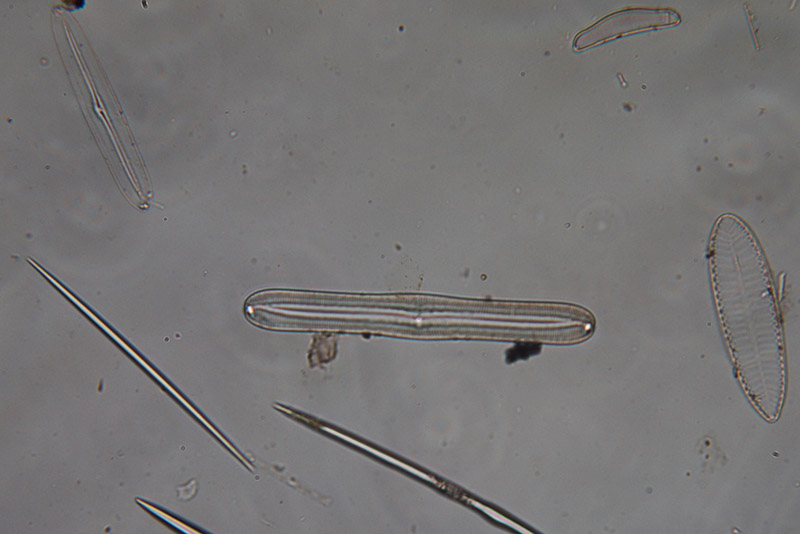John Francis Walkingame Tatham, 1844-1924
by Brian Stevenson
last updated June, 2018
A well-regarded public health official, physician, and head of the UK General Records Office, John Tatham was also deeply involved with microscopy. He was a member and officer of the Manchester Microscopical Society, the Royal Microscopical Society, and the Quekett Microscopical Club. Known examples of his microscopical specimens date from his time in Manchester (before 1893, see Figure 1 and Bracegirdle). Presumably, he continued to make slides after his move to London, although none are yet publicly known.

Figure 1.
Microscope slides that were prepared by / owned by John Tatham. Dated 1874 and 1875, these would have been from his time in Manchester. The rightmost slide, of Podura scales, is additionally marked “J. Broadbent”, suggesting that Tatham acquired either the specimens or completed slide from Dr. Broadbent. A similar slide, also of Podura scales, is shown in Bracegirdle’s ‘Microscopical Mounts and Mounters, plate 34-F

Figure 2.
John F.W. Tatham. Adapted for nonprofit, educational purposes from the web site of the Manchester Microscopical Society, http://www.manchestermicroscopical.org.uk/tatham.jpg
Two biographies of Tatham’s professional life are appended to this essay. I will focus on his work as a microscopist, and other aspects not covered in the accompanying biographies.
John Tatham was born on March 24, 1844, in Bradninch, Devonshire. He was the eldest child of Leonard F. and Sarah Tillman Tatham. Leonard was a druggist, grocer, and tea dealer. The 1861 census recorded the 17 year-old John as being an assistant in his father’s shop.
Shortly afterward, he attended medical school in Glasgow, and in 1867 passed the LFPS and LRCP examinations of Glasgow and Edinburgh, respectively. He then took a position at Sheffield Hospital. In 1869, Tatham was appointed Junior House-Surgeon to the Ardwick and Ancoats Dispensary, Manchester. The 1871 census recorded him as surgeon of the Salford Union Workhouse, and living at that facility. For many years afterward, he was Medical Health Officer for Salford and Manchester. He took a diploma in public health from Cambridge in 1876, and M.D. from Trinity, Dublin in 1884.
John married Mary Sophia Jones in Salford in 1873. They had two children, a boy and a girl. Tatham’s professions brought in a comfortable income, enabling them to have cooks and housemaids.
Tatham was seriously involved with amateur aspects of microscopy by the mid-1870s. A review of Manchester’s Leeuwenhoek Microscopical Club states, “On September 30th, 1875, a meeting took place at the house of Dr. John Tatham, at which it was resolved to continue the work of the Club with a membership of five, consisting of: Charles Bailey FLS, John Boyd, John Barrow, John Hardy, (and) John Tatham MA MD. … Dr. Tatham became president in October, 1886 and was re-elected in 1887, and again in 1888”.
He served as President of the Manchester Microscopical Society in 1880. That year, Tatham also served as executor to the estate of physician and amateur microscopist John Redmayne. In 1889, he joined the Manchester Literary and Philosophical Society.
John Tatham moved from Manchester to London in 1893, to manage the General Records Office.
Tatham was elected as a Fellow of the Royal Microscopical Society, and served on its Council for several years. In 1895, Tatham was elected to membership in the Quekett Microscopical Club, and soon served on its Council. He served as the Quekett Club’s President from 1898-1899.
John retired from the General Records Office in 1903. In 1917, he became a minister and became Curate of Tandridge, Surrey. He died on November 8, 1924.
A brief summary of Tatham’s professional life, from the Lives of the Fellows of the Royal College of Physicians:
“b.24 March 1844 d.8 November 1924. MD Brux(1875) DPH(1876) BA Dubl(1884) MB(1884) MA MD LFPS Glasg LRCP Edin DPH Cantab FRCP(1898) Hon FRCPI. John Tatham, who came of an old Cumberland family, was brought up in Exeter. He studied medicine at Sheffield, and took the Glasgow and Edinburgh diplomas in 1867. In 1870 he became house surgeon to the Ardwick and Ancoats Dispensary and three years later medical officer of health for Salford (note: according to The Lancet, 1869, this appointment was made in October, 1869). Here he gave evidence of statistical leanings, by publishing statistical tables in his annual reports, and by arranging for the exchange of returns of infectious diseases with other medical officers of health, thus laying the basis of the compulsory weekly returns to the Local Government Board finally established in 1910. In 1888 he obtained the same post at Manchester, having acquired the Brussels M.D. degree (1875), the Cambridge D.P.H. (1876), and the Dublin B.A. and M.B. degrees (1884), during his stay at Salford. In 1890 he became lecturer on public health at Owens College, and in 1892 he published the first Manchester Life Tables, which he later supplemented with tables covering the decade 1891-1900. In 1893 he was selected for the post of superintendent of statistics in the General Register Office, which he held until he reached the retiring age in 1909. Tatham’s best work was embodied in two letters to the registrar-general, summarising the vital statistics of the decades 1881-90 and 1891-1900, which proved worthy successors to the supplementary reports of Farr and William Ogle. He examined on public health for the Universities of Cambridge and Wales, and contributed to Allbutt and Rolleston’s System of Medicine. In retirement Tatham, a man of cautious and clear judgement and fine presence, and a good speaker, lived first at Lynton and then at Oxted. In 1917 he took Holy Orders and became curate of Tandridge, Surrey. He died at Oxted”.
Further details from Edward Higgs:
“John F. W. Tatham (1844–1924) held the post of Superintendent of Statistics at the General Register Office (GRO), the body responsible for census-taking and the civil registration of births, marriages and deaths, from 1893 to 1909. He was plainly a man of learning, and made important contributions to medical statistics, but he was perhaps not as innovative a figure as the other men who held the post of Superintendent in the years before 1920.
Tatham graduated in medicine in Glasgow in 1867, and obtained the diploma in public health at Cambridge in 1876. In 1884 he graduated in medicine and arts at Trinity College Dublin, and proceeded to his M.D. two years later. From 1873 to 1892 he was a medical officer of health, first for Salford and then from 1888 for Manchester. Whilst in Manchester he produced life tables for the city, and was lecturer on hygiene at Owen College.
On taking over from William Ogle at the GRO in 1893, Tatham's contributions to the Office's flagship publication, the Annual Report of the Registrar General for England and Wales (ARRG), were at first anonymous. Under Brydges Henniker, the Registrar General from 1880 to 1900, the ARRG was only signed by Henniker, although the Superintendent of Statistics must at least have provided the data included. From 1902, however, a new Registrar General, Sir William Cospatrick Dunbar, reintroduced the separate 'Letter to the Registrar General from the Superintendent of Statistics on mortality that had been a feature of the pre-Henniker days. Dunbar's reason for instituting was that 'it occurs too me that the medical practitioners of this country, on whose generous co-operation the accurate compilation of vital statistics so largely depends, will, in this way, more readily appreciate the fact that the particulars they contribute concerning the causes of death are analysed, and the results authenticated, by a member of their own profession. This was more generally associated with an expansion in the size of the GRO's publications, and in the institution's staffing.
Tatham's contribution to the GRO's main publication was then more obvious and his work blossomed. In the ARRG published in 1904, Tatham noted improvements in the statistics published since the end of the last century, including supplementary tables on infected organs/parts of the body; on deaths in childbirth; and on deaths from specific diseases discriminating between urban/rural areas. He also discussed attempts to correct for age when calculating local rates of mortality, building on work initiated by his predecessor, William Ogle. Tatham's later Letters also gave great emphasis to infant mortality. This had not declined in the same way as mortality in other age groups, and in 1906 the President of the Local Government Board called a conference of medical officers of health to consider this question. The chief medical officer of the Board had subsequently taken steps to gather special returns from medical officers on mortality in infants, and Tatham's own work on the subject was to act as a reference point for them.
Tatham also published two Supplements to the Annual Report of the Registrar General, both under his own name, in which he looked at trends in the mortality data for the decades 1881 to 1890, and 1891 to 1900. Both were in two parts, the second volumes extending work undertaken by William Ogle on occupational mortality. The first volume of the Supplement covering the years 1891 to 1900, published in 1907, also contained a distinct section on mortality rates for infants and young children, in line with developments in the ARRG for that year. Tatham was also responsible for the analysis of the data for the 1901 census. This contained an extra column for 'working at home' but does not appear to have been an innovation sponsored by Tatham personally.
During his time at the GRO, Tatham was also in demand for appearances as an expert witness at numerous committees of enquiry. He appeared before the Inter-Departmental Committee on Gas Poisoning, the Royal Commission on Tuberculosis, the Select Committee on Death Certificates, the Royal Commission on the Feeble Minded, the Royal Commission on Arsenical Poisoning, and the Lords Select Committee on Infant Life Protection. He was also a member of the 1904 Inter-Departmental Committee on Physical Deterioration, and of the Imperial Cancer Research Fund Committee. He was also president of the Society of Epidemiology. Tatham retired in 1909, and in 1917 he took holy orders at the age of 73, subsequently serving as a curate at Tandridge in Surrey”.

Figure 3.
The Leeuwenhoek Microscopical Club, March 1890. Left to right, Mark Stirrup, William Blackburn, John Barrow, John Boyd, John Tatham, Charles Bailey, and John Pettigrew.

Figure 4.
10x magnified view of Navicula, etc., mounted in 1875 by John Tatham (see Figure 1).
Resources
Bracegirdle, Brian (1998) Microscopical Mounts and Mounters, Quekett Microscopical Club, London, pages 91 and 172, and plate 34-F
British Medical Journal (1909) Report of the retirement dinner held for Tatham, Vol. 1, pages 1551–1552
British Medical Journal (1924) Obituary of John F.W. Tatham, Vol. 2, pages 978–979
Brown, G.H. (Accessed November, 2015) Lives of the Fellows of the Royal College of Physicians, Vol. 4, page 406, accessed through http://munksroll.rcplondon.ac.uk/Biography/Details/4348
England census, birth, marriage, and death records, accessed through ancestry.co.uk
Hartog, J. (1900) The Owens College, Manchester (founded 1851); A Brief History of the College and Description of its Various Departments, J.E. Cornish, Manchester, “Appointed 1890, J.F.W. Tatham, M.D.; resigned 1893 (now Superintendent of Statistics, Registrar-General's Office, London”, page 107
Higgs, Edward (accessed November, 2015) John F.W. Tatham (1844-1924), Accessed from Online Historical Population Reports, http://histpop.org/ohpr/servlet/View?path=Browse/Essays%20%28by%20kind%29&active=yes&mno=2139
Journal of the Quekett Microscopical Club (1895) “February 15th, 1895, Annual Meeting … The following gentlemen were balloted for and duly elected members of the Club: … Dr. Tatham", Second series, Vol. 5, page 56
Journal of the Quekett Microscopical Club (1895) “Members: … Feb. 15, 1895. Tatham, John, M.A., M.D., F.R.M.S., Rathronan lodge, The Avenue, Berryland, Surbiton", Second series, Vol. 5, page 56
Journal of the Quekett Microscopical Club (1898) “January 21st, 1898 - Ordinary Meeting, J.G. Waller, Esq., F.S.A., President, in the Chair … The nominations made by the Committee were then read: As President. Dr. Tatham … The Secretary said it would be necessary for the members to nominate for five vacancies on the Committee in place of the four senior members who retire in rotation, and in place of Dr. Tatham, who had been proposed as President … The retiring President then read his Annual Address, at the conclusion of which he requested Dr. Tatham to take the chair as the newly elected President of the Club … Dr. Tatham said that his first duty and his first pleasure on occupying the chair was to offer the members of the Club his cordial thanks for the honour done him by appointing him President of the Club, He had only been a few years in London, but he had been a microscopist all his life, and as soon as he was settled he put himself in communication with those of similar tastes and got some one to propose him as a member. He always looked forward to the meetings with pleasure, and had always been treated so cordially and kindly that he might say that some of the happiest hours he had spent since he came to London had been spent in that room. He hoped they would accept his hearty thanks, and at the same time his assurance of every endeavour on his part to promote the well-being of the Quekett Microscopical Club.", Second series, Vol. 7, pages 45-50
Journal of the Royal Microscopical Society (1900) Members of Council
The Lancet (1869) “J.F.W. Tatham, L.R.C.P.Ed., appointed Junior House-Surgeon to the Ardwick and Ancoats Dispensary, Manchester”, Vol. 2, page 596
Manchester Microscopical Society (Accessed November, 2015) Web site, http://www.manchestermicroscopical.org.uk
Medical Times and Gazette (1867) “The following gentlemen … passed their First Examination: John F. W. Tatham, Sheffield Hospital”, page 53
Memoirs and Proceedings of the Manchester Literary and Philosophical Society (1889) Election of J. Tatham, page 4
Northern Microscopist (1881) Report of the annual meeting of the Manchester Microscopical Society, Vol. 1, pages 95-96
Probate of John Thomas Redmayne (1880) Accessed through ancestry.co.uk
Quekett Journal of Microscopy (2012) “Past Presidents, 1897-1899 – John Tatham”, Vol. 41, page 791 (Club records indicate that Tatham was first elected in January, 1898, and re-elected the following year)
A Review of the Work of the Leeuwenhoek Microscopical Club, Manchester, From October, 1867, to March, 1891. in
Pamphlets on
Protozoology (Kofoid Collection), Vol. 298, page 323, , on line at http://books.google.com/books?id=jmA0AAAAIAAJ
Tatham, John (1886) Illumination of objects under the microscope, Transactions and Annual Reports of the Manchester Microscopical Society, pages 78-79
Tatham, John F.W. (1899) The President’s Address, Journal of the Quekett Microscopical Club, Second series, Vol. 7, pages 180-189
Tatham, John W. (1899) About stands and accessories, American Monthly Microscopical Journal, Vol. 20, pages 201-206
Tatham, John F.W. (1900) The President’s Address, Journal of the Quekett Microscopical Club, Second series, Vol. 7, pages 299-308
Tatham, J.F.W. (1901) Media for mounting diatoms, Journal of the Royal Microscopical Society, pages 94-95



